|
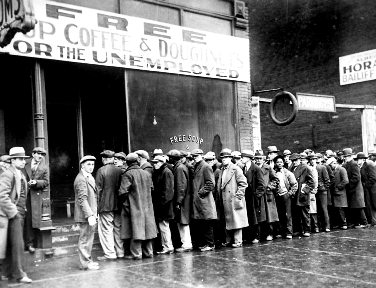
Great Depression - Soup Kitchen
|
President Herbert Hoover
Herbert Hoover was
the 31st US President who served in office from March 4, 1929 to March 4, 1933. One of the
most important events during his presidency was the
beginning of the period in US history known as
the Great Depression.
Great Depression Facts: Fast Fact Sheet
Fast, fun facts and Frequently Asked Questions (FAQ's)
about the Great Depression.
When did the Great Depression start? The Great Depression
started with the Wall Street Crash which
occurred on October 29, 1929 (Black Tuesday)
When did the Great Depression end? The Great Depression
lasted for ten years and ended in 1939 as
WW2 broke out. The worst year of the Great
Depression was 1933.
What was the Unemployment Rate during the
Great Depression:
The Unemployment Rate during the Great Depression
in 1933 was 25%. Over 12 million people were
unemployed with over 12,000 people being
made unemployed every single day at the
height of the Great Depression.
What Caused the
Great Depression?
The Great Depression
was caused by many different factors including
false sense of prosperity in America, the 1929 Stock Market Crash,
Bank failures, lack of credit, bankruptcies, unemployment, reduction
in purchasing, American economic policy and failures by the Federal
Reserve, loss of exports, drought conditions and the Dust Bowl.
For comprehensive facts and information refer to the Causes and
effects of the Great Depression.
Great Depression
Facts for kids
The following fact
sheet contains interesting facts and information on Great Depression
and what happened to the American people during this devastating
period in American history.
Facts
about the Great Depression for kids
Great Depression Fact 1:
The
Roaring Twenties had been an
exciting period in America with new inventions,
technical innovations and changing lifestyles. The
feeling of exuberance and invincibility disappeared
almost overnight triggered by the
1929 Wall Street Crash
and economic collapse in the United States.
Great Depression Fact
2: The Great Depression was aptly named
reflecting both the long and severe recession in the
American economy and the feelings of dejection and
despair experienced by the American people.
Great Depression Fact 3:
The Great Depression began with the Wall Street
Crash in October 1929. Just six months before, on March 4, 1929,
Republican President Herbert Hoover, riding on a wave of optimism,
had been inaugurated as President of the United States.
Great Depression Fact 4:
His sense of optimism, shared
by so many Americans before the economic collapse, was conveyed in
one of his campaign speeches on the potential of America towards
ever greater economic prosperity."We in America
today are nearer to the final triumph over poverty than ever before
in the history of any land.
We shall soon, with the help of God, be in sight of the day when
poverty will be banished from this nation."
Great Depression Fact 5:
During the euphoria of the Roaring Twenties many
of the once "thrifty and prudent" American public adopted the modern
philosophy of "Live now, pay later" and bought expensive products,
like automobiles, on easy credit terms.
Great Depression Fact 6:
Ordinary, Middle Class Americans had
invested in the Stock Market. By 1929 nearly 4 million
Americans (about 10% of US households) had invested in the stock market
" Buying on Margin" meaning that they were buying shares
with loans.
Great Depression Fact 7:
The levels of debt effected the
ability of many Americans to survive the effects of the
Great Depression. The number of suicides jumped to an
alarming 18.9 per 100,000 in 1929, the year of the Wall
Street crash.
Great Depression Fact
8: There was an uneven distribution of
income in America. Lower class, poor Americans were in
the majority (60%) - these people were suffering even
before the Great Depression and had limited spendable
income.
Great Depression Fact
9: Those Americans who had money and
remained "thrifty and prudent" also suffered. They had
placed their money in banks for safe keeping. Many were
small banks who had also recklessly invested in the
stock market and lent money to stock market investors.
Great Depression Fact
10: The federal government did not insure
bank deposits. If a bank collapsed its customers lost
all their savings. During 1929-1931 over 3000 banks went
bankrupt - over 10% of the nation's total and more
followed as the Great Depression deepened.
Great Depression Fact
11: People were desperate to get their
money out of ailing banks which led to a series of
banking panics called Bank Runs. There were numerous
Bank Runs at the same period of time which led to
financial crisis and a chain of bankruptcies.
Great Depression Fact 12:
Rumors would circulate that a bank was about to
collapse. People scrambled to withdraw their money. As a bank run
progressed, it generated its own momentum in a kind of
self-fulfilling prophecy. As people withdrew their money, even more
people made withdrawals. The bank would run out of cash and become
bankrupt.Continued...
Facts
about the Great Depression for kids
Facts
about the Great Depression for kids
The following fact
sheet continues with facts about Great Depression
Facts
about Great Depression for kids
Great Depression Fact 13:
On Monday 25 October, 1929, as the stock market
was going into freefall, President Hoover tried to allay the fears
of the American public made the following statement:
"The fundamental business of the
country, that is, production and distribution of commodities,
is on a sound and prosperous basis.."
Great Depression Fact 14:
Four days later, the stock market
crashed and the Great Depression followed. The
credibility of the president was lost. At the time when
strong leadership was essential to Americans, confidence
in the president was at an all time low and Herbert
Hoover bore much of the blame for the Great Depression
in the minds of the American people. His reputation was
tarnished even further as he failed to recognize the
severity of the situation, was perceived as insensitive,
and failed to take effective measures to address the
problems.
Great Depression Fact
15: What did the Hoover Administration
and the Federal Government do? The measures taken by
President Hoover and the federal government included the
following:
●
1930 Hawley-Smoot Tariff
created protective tariffs (taxes) and increased
rates on imported goods
● 1931 Federal Home Loan Act
was passed creating the Home Loan Board and the
creation of banks to handle home mortgages. The
Federal Home Loan Banks received $125 million in
capital
● In October 1931 the National
Credit Corporation was created to encourage the
largest banks in the country to establish lending
agencies to lend money to small banks on the brink
of foreclosure, that could be used for loans
● 1931 Wagner-Graham
Stabilization Act was passed to set up the Federal
Stabilization Board to initiate public works such as
dams and highways
● The 1931 Keyes-Elliott Acts
appropriated an additional $330 million for Federal
buildings and construction projects in order to aid
employment
● Congress passed the Emergency
Relief and Construction Act of 1932 to create the
Reconstruction Finance Corp. (RFC). The RFC was
designed to give out loans to banks, railroads, and
companies in order to pump money back into the
economy
● The Emergency Committee for
Employment was set up August 19, 1931 in an attempt
to mobilize private charity and encouraged states
and cities to increase public works spending. It
ended on June 30, 1932 because the government was
not willing to help the agencies with the aid of
money
● Public Works Programs were
initiated, such as the construction of the
Hoover Dam
Great Depression Fact 16:
The Great Depression sparked civil
unrest and a series of Hunger Marches by WW1 veterans. On December 5,
1932 nearly 2000 people marched to Capitol Hill in
Washington chanting "Feed the hungry, Tax the rich".
They were soon dispersed but there action inspired other
veterans to march to Washington later in the year.
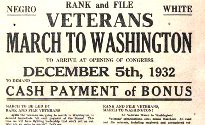
Great Depression Fact 17:
The
Bonus Army March took place in
the summer of 1932 as WW1 veterans marched to Washington
to lobby Congress to pass legislation authorizing the
early payment of $1000 veterans bonuses. The bill was
not passed. Some veterans, with no where else to go,
stayed in Washington living in unoccupied building and
makeshift camps. The government called in the army to
remove the veterans. The US Army, under Douglas MacArthur, used extreme and violent tactics to remove
the veterans.
Great Depression Fact 18:
Over 20,000 companies and business
went bankrupt and closed at the start of the Great
Depression. People were laid off work and their were no
opportunities for new employment.
Great Depression Fact 19:
Between 1929 and 1932 construction
projects fell by 80% contributing to the high levels of
unemployment.
Great Depression Fact
20: By 1933 the number of unemployed
reached the staggering figure of 12 million (25% of the
population). 70,000 factories were closed by 1933.
Great Depression Fact
21: People had no jobs and no money and
many went hungry. There was no benefits system and
people were literally starving. Americans were forced to
join 'Bread Lines' for free handouts of food,
in particular bread. There were so many impoverished
people that the Bread Lines sometimes stretched over
several blocks.
Others lined up at 'Soup
Kitchens',
established by charities, where food was served to the
hungry. The picture illustrates a typical Soup Kitchen
in the 1930's.
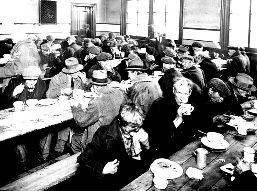
Great Depression Fact
22: Shanty towns (Hoovervilles):
Due to unemployment Americans were unable to pay their
bills. Many unfortunate tenants were evicted by
bailiffs. Homeless Americans had no alternative but to
set up shacks on unused or public lands. The photograph
of the children living in a 1930's shantytown conveys
the plight and the living conditions forced on American
citizens who had been made homeless, through no fault of
their own, during the Great Depression. Nearly 50% of
children did not have adequate food, shelter, or medical
care. For more facts refer to
Shantytowns and
Hoovervilles
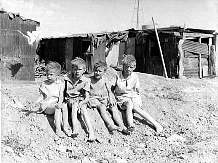
Great Depression Fact
23: Hobos: Many men
and young boys became hobos during the great Depression.
Many absented themselves from their families in search
of jobs anywhere in the country. Many unemployed men
felt they were a burden consuming scant food rations
available to their families. The easiest way to travel
around the country was by train and hobos would ride on
open boxcars or in freight trains to each new
destination. Shantytowns, called 'Hobo Jungles' sprang
up by railroad stations.
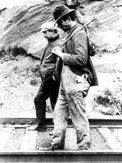
Great Depression Fact
24:
Dust Bowl: Farmers
had experienced a difficult time in the 1920s. It got
worse in the 1930s. In 1932 a devastating drought hit
the farmers in North and South Dakota, Nebraska, Kansas,
Oklahoma, and New Mexico. With no rainfall the
soil turned to dust. Violent winds whipped the dry soil
creating terrifying dust storms. The dust got
everywhere, crops were ruined and livestock were killed.
Farmers lost their lands and homes to the foreclosures
by the banks. The dust bowl and the dust storms
destroyed 100 million acres of land. Over 3 million
impoverished people became homeless and many had no
alternative but to head west to California away from the
devastation of the prairie states.
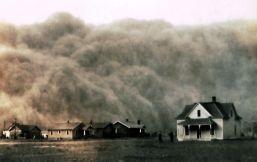
Great Depression Fact
25: The Los Angeles Police Department
established the "Bum Blockade," in the illegal attempt
to block immigrants from the Dust Bowl from crossing the
California border
Great Depression Fact
26: During the Great Depression author
John Steinbeck wrote "The Grapes of Wrath" and "Of Mice
and Men" about the lives of the people living in the
Prairies states and the devastating effects of the Dust
Bowl.
Great Depression Fact
27: Americans sought to escape the
horrors of the Great Depression by listening to the
radio or spending a dime to go to the movies.
60-80 million Americans went to the movies every week. The biggest hit song of 1932 was "Brother, Can You
Spare a Dime?" by Bing Crosby. The most popular films
during the era were 'Gone with the Wind', 'Snow White
and the Seven Dwarfs', 'King Kong', the 'Wizard of Oz'
and 'Mr. Smith goes to Washington'.
Great Depression Fact
28: Crime increased during the Great
Depression. Amongst the Americans, who followed in the
path of Al Capone, turned to crime
during the period were Bonnie and Clyde, John Dillinger,
"Baby Face" Nelson, Machine Gun Kelly, Pretty Boy Floyd
and the Ma Barker gang.
Great Depression Fact
29: The Stock Market: By 1932 industrial
stocks lost 80% of their value since 1930.
Great Depression Fact
30: International Trade: The Wall Street
Crash had impacted across the globe sending other
countries into recession. This, and the high tariffs on
imported goods to America led to a massive fall in
International trade. Between 1929-1932 international
trade fell by a massive 70%.
Great Depression Fact
31: Income Tax: The top rate of tax was raised from
25% to 63% but this measure was seen as too little, too
late.
Great Depression Fact
32: The Great Depression peaked between
1932 and 1933 when things slowly started to improve.
Great Depression Fact
33: Not surprisingly Herbert Hoover
failed to retain the presidency and on March 4, 1933 the
Democrat, Franklin D. Roosevelt, was inaugurated as the
new president of the United States with new ideas to
beat the recession and a plan to redistribute wealth
from the rich to the poor, boldly stating that:
"..the only thing we have
to fear is fear itself - nameless, unreasoning,
unjustified terror".
The period in American history known
as the
New Deal was about to
begin.
Great Depression Fact
34: In the 'First 100 Days' the Roosevelt
presidency started with intensive legislative activity
and Congress passed 15 important acts to combat the
economic crisis - these actions were referred to as the
'First New Deal' encompassing his policies of
Relief, Recovery
and Reform.
Great Depression Fact
35:
President Roosevelt's New Deal
Programs would
become the biggest, most expensive government
initiatives
introduced by any American President. His first goal was
to stabilize the banking system. The Emergency Banking
Relief Bill brought all banks under federal control.
Great Depression Fact
36: President Roosevelt realized that he
had to win back the confidence of the American people.
He used the power of communication via the radio and
established a weekly broadcast called the "Fireside
Chats" to speak directly to Americans.
Great Depression Fact
37: The Second New Deal emerged in 1935 -
1936 established more radical and reforming policies.
These included the
Works Progress Administration, the
Rural Electrification
Administration and the National Labor Relations Act.
The federal organizations that were created to
provide practical were nicknamed “Alphabet Agencies,”
such as the TVA, NRA, CCC, AAA and PWA.
Great Depression Fact
38: World War 2 broke out in 1939 and the
United States entered the conflict on December 7, 1941.
At this point the economic output in America surged and
unemployment fell - refer to
US Mobilization for
WW2
Great Depression Fact 39:
And so the Great Depression came to
an end, only to be replaced by devastation caused by
WW2.
Facts
about Great Depression for kids
Facts
about
Great Depression for kids
For visitors interested in the history of
the Great Depression refer to the following articles:
Great Depression - President Herbert Hoover Video
The article on the Great Depression provides detailed facts and a summary of one of the important events during his presidential term in office. The following
Herbert Hoover video will
give you additional important facts and dates about the political events experienced by the 31st American President whose presidency spanned from March 4, 1929 to March 4, 1933.
Great Depression
●
Interesting Facts about Great Depression for kids and schools
●
Summary of the Great Depression in US history
●
The Great Depression, a major
event in US history
●
Herbert Hoover from March 4, 1929 to March 4, 1933
●
Fast, fun facts about the Great Depression
●
Foreign & Domestic
policies of President Herbert Hoover
● Herbert Hoover Presidency and
Great Depression for schools,
homework, kids and children |